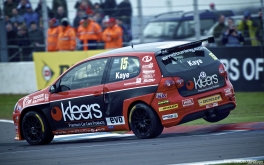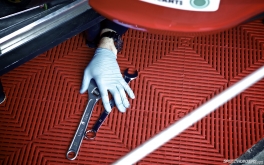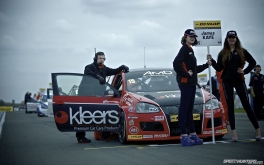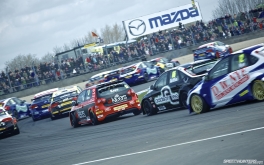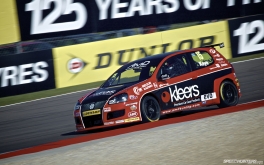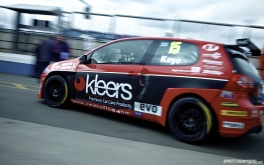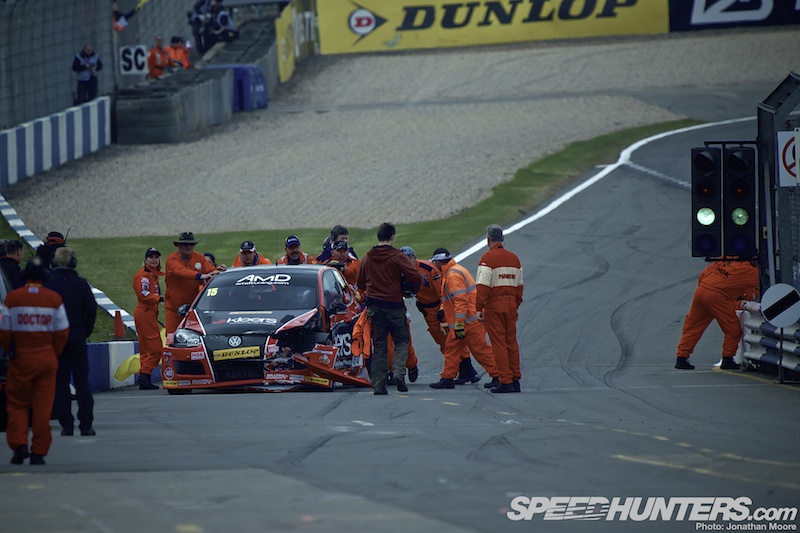
The weekend had been going great for AMD Tuning. Just two hours previously their BTCC Golf had finished the morning race in first place. But in front of my eyes the front of this previously pristine racing car had just been reduced from a potential double winner to several large pieces after barely 100 yards of racing at the start of the second race. It’s bad enough to witness from the side of the track; worse still when you’re a member of the team or were in the driving seat at the time. What does a team do in that situation? Give up and go home? Or swing into action and try and get the car back on track for the final race, just two hours away? As I saw James Kaye’s VW Golf spear across the track and hit the wall, I was thinking that surely it would be game over for the weekend, with no chance of the team making that third race… I was about to find out what it takes to put a race car back together under extreme pressure.
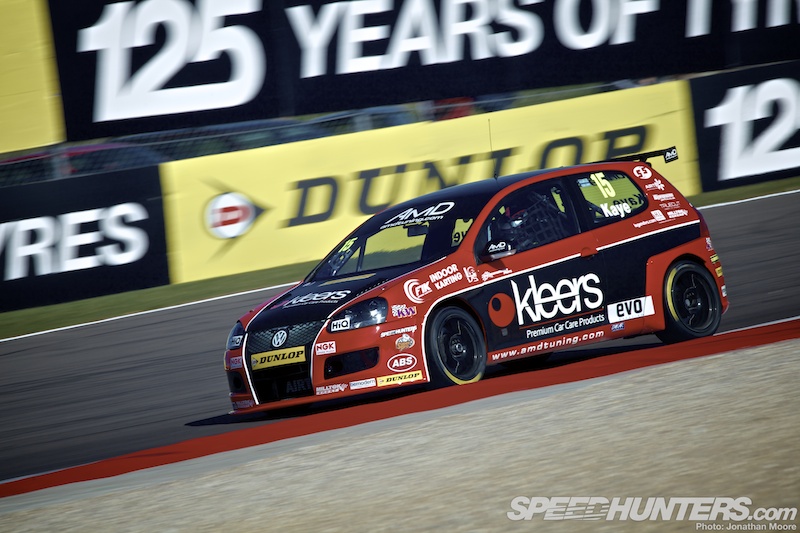
On the previous day of the second round of the British Touring Car Championship at Donington Park, the AMD Tuning team had been riding a wave: fastest in the S2000 Jack Sears Trophy class for both practice sessions and on pole in qualifying for their VW Golf. Veteran racer James Kaye was seven tenths clear of the next fastest S2000 car and in with the tail-end Next Generation Touring Car class teams. Come Sunday morning, the first race of the day went off exactly as the team wanted.
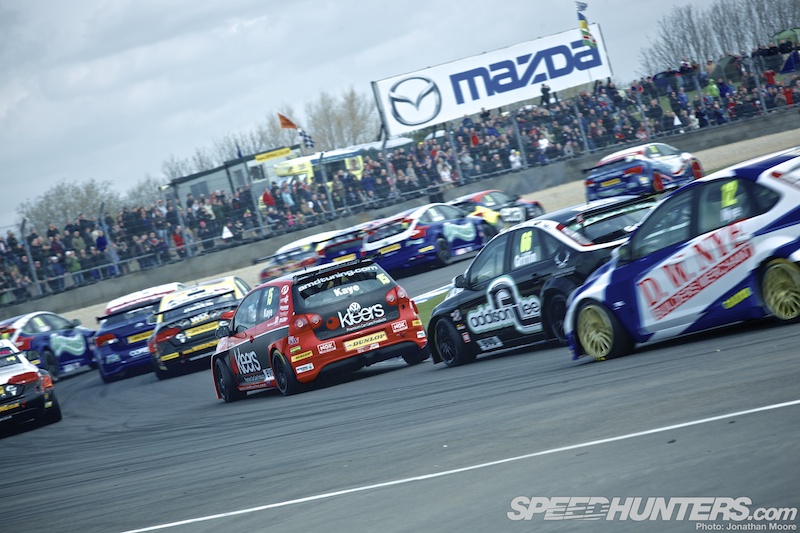
The Golf sprinted off the line as the lights went green, and James kept his S2000 rivals at bay for the duration of the 16 lap race. He crossedthe line in 19th overall, winning the class.
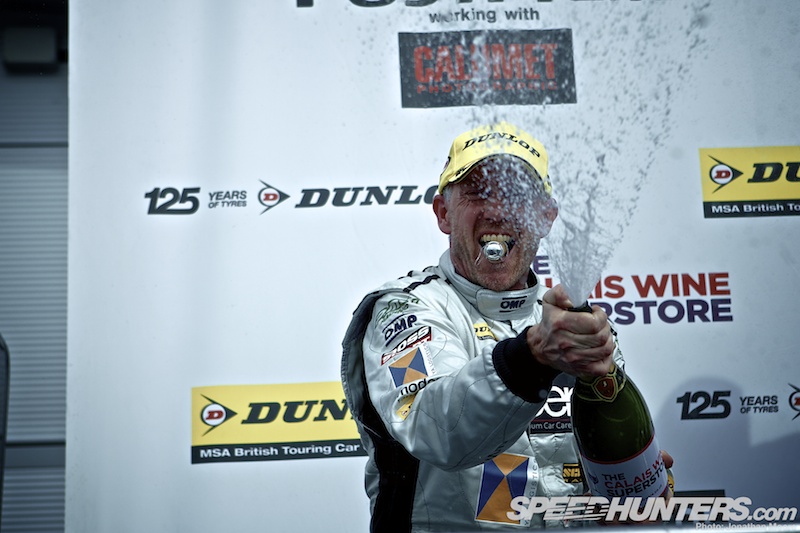
James celebrated with a spray of champagne on the podium: things were looking good for the following two races and I was fully expecting to be wiping more bubbly off my lenses later in the day.
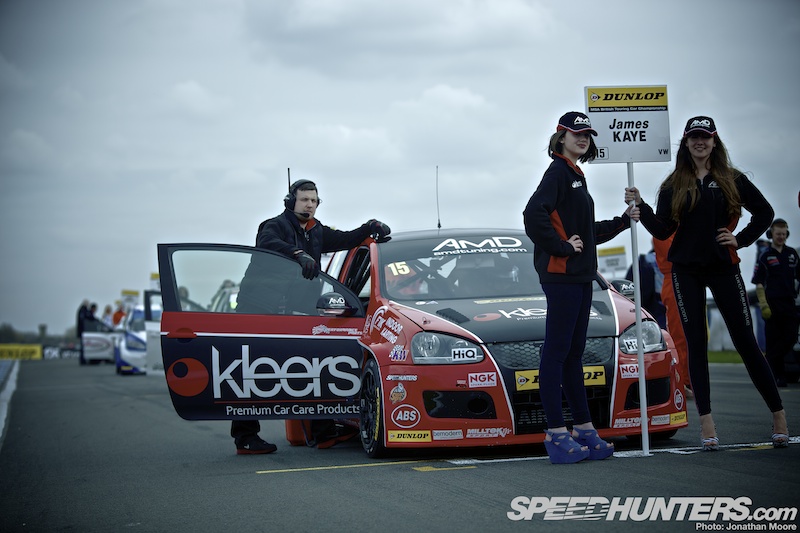
But as so often in racing, the team’s fortunes were to change dramatically. The Golf lined up at the head of the S2000 class cars for the second race of the day, to the rear of the mid-field – always a frantic place to be at the start of the course.
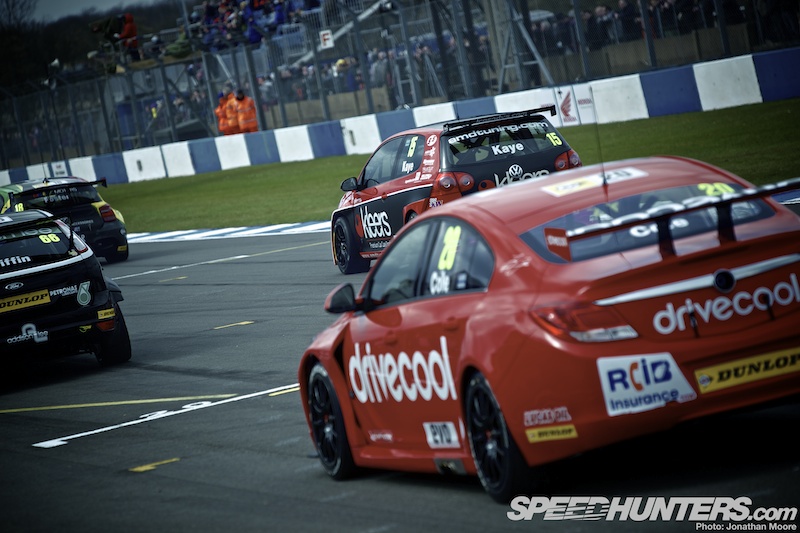
But this time the AMD Tuning VW wouldn’t even make the first corner.
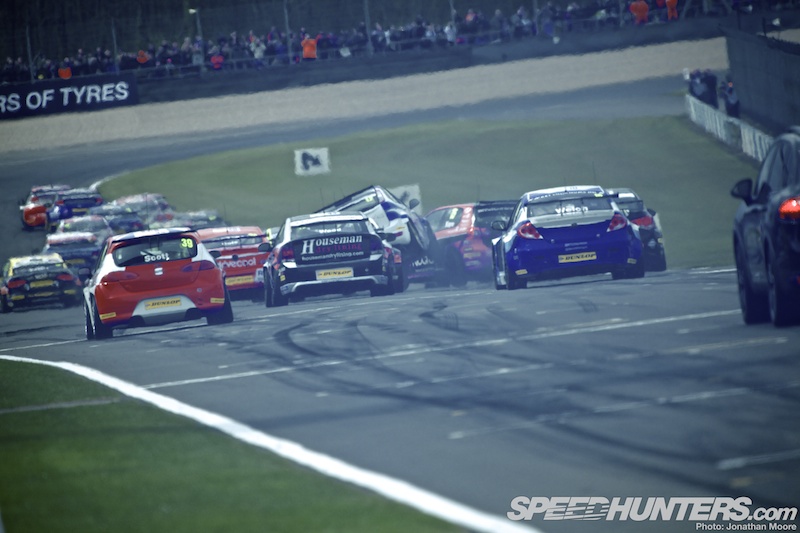
As the pack charged down to Redgate at 2:30pm, James was forced to minutely ease off as a car in front stuttered. The Ford Focus on his tail didn’t react in time and rode up over the side of the Golf. It seemed bad from where I was standing, but initially survivable – the Focus looked like it would come back down to earth and maybe push the Golf straight…
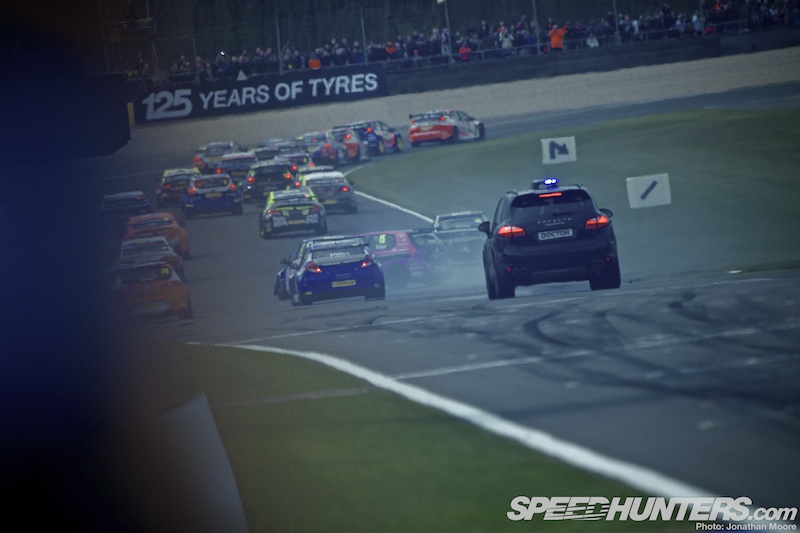
…but no. The two cars remained locked together, and as the other cars scattered around the emerging accident, the Golf and Focus speared off to the left and into the concrete pit wall. I jogged back to the pit lane, arriving a couple of minutes later to see the Golf being pushed into the safety of the pit lane exit: it looked like the car would be recovered to the garage pretty much straight away.
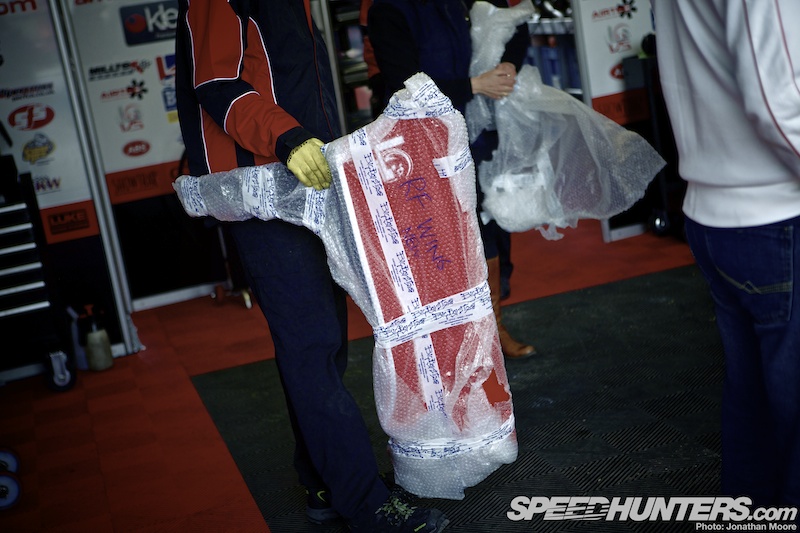
In the garage, the team had already sprung into action. Even though the exact damage wasn’t known, the major components that were likely to be required were already being taken out of the team’s spares stock and unwrapped in preparation, ready for work to begin as soon as the car arrived.
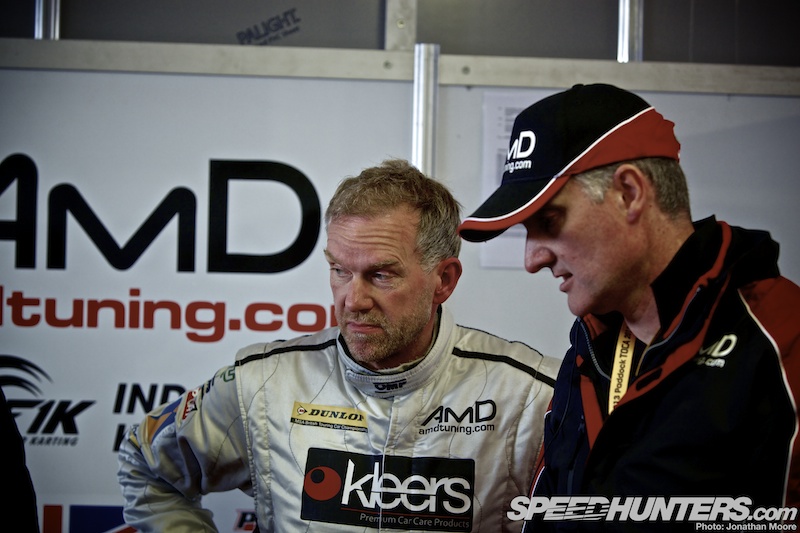
Things went from discussing rebound to how to rebuild a touring car in just two hours. From set-up to survival. I’m beginning to think that I curse touring car teams: similar things have happened with a BMW at the Pau street circuit in France and the Motorbase team when they were running Seat Toledos in the BTCC a couple of years back! But the reaction was the same in both occasions – and for racing teams in general: if there’s a chance that the car can get back out, you do everything you can.
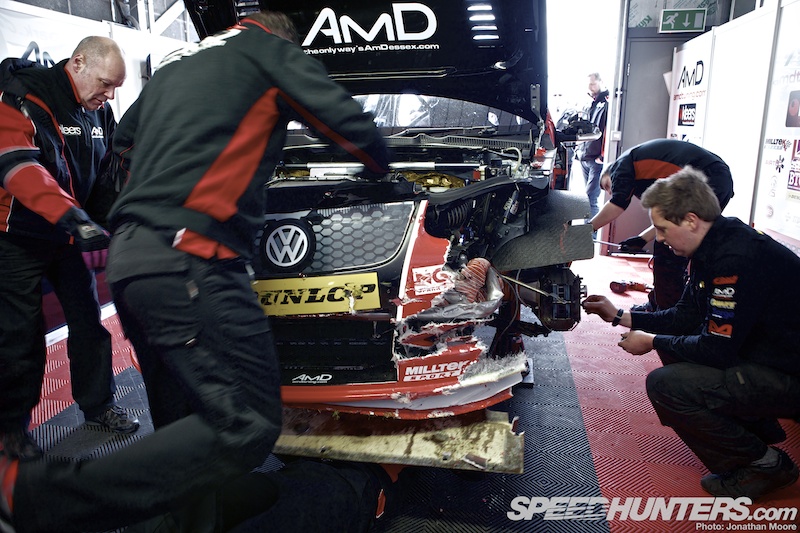
I take absolutely no joy in the circumstances that lead up to this kind of incident, but I can’t deny that it’s captivating to see how a team reacts, and watching the rebuild process is really rather exciting. Just over two hours of frantic work ensued: amazingly with smiles and jokes despite the pressure. Privateers they might be, and a collection of full-time AMD Tuning staff and weekend warriors, but their professionalism was clear to see as they worked away with the clock ticking. It was 2:38pm: the pit lane would open for the final race at 5pm.
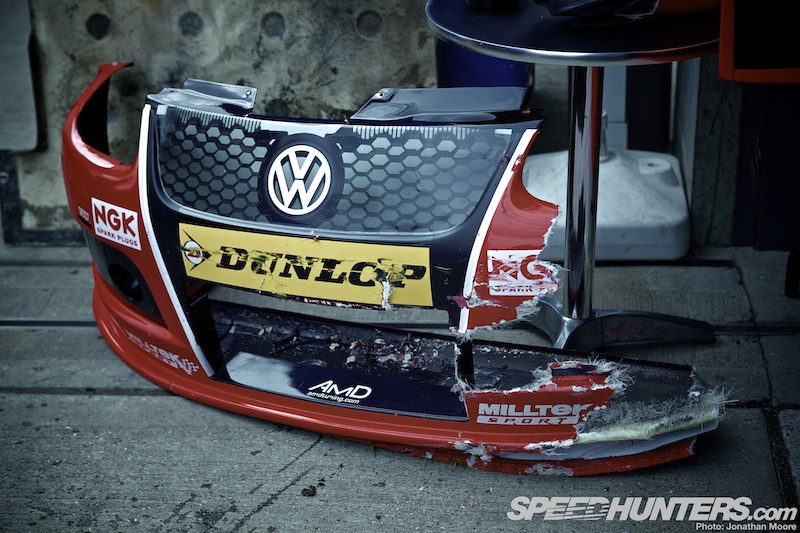
The first thing to do was strip away the damaged parts to reveal the extent of the damage.
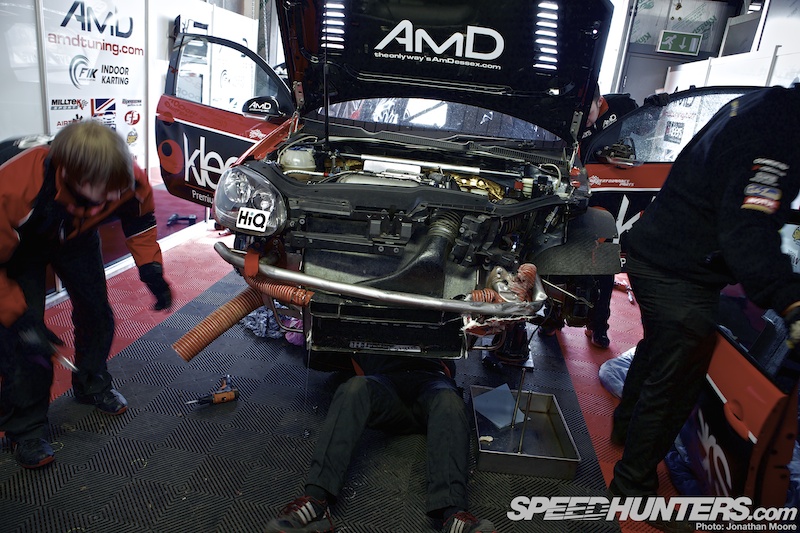
Luckily the engine itself seemed to be okay, but the Golf had taken a serious impact on the front left as it hit the wall. The frontal crash bar was completely crumpled, the left headlight and mount smashed, the radiator heavily damaged and the cooling hoses a mess.

The Focus had ridden up the side of the Golf, caving the door in: that had to be knocked off the hinge and removed.

The pins and mountings had mercifully only sustained light damage: the new door seemed to go on relatively easily…
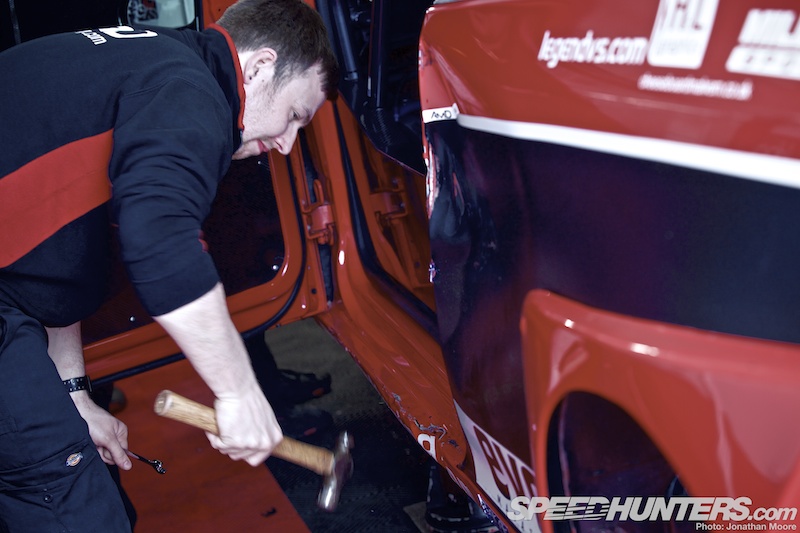
… but the sill had also sustained damage and required some persuasion to allow the new door to close. Spanners might be an important tool in the mechanic’s arsenal, but so is a hammer!
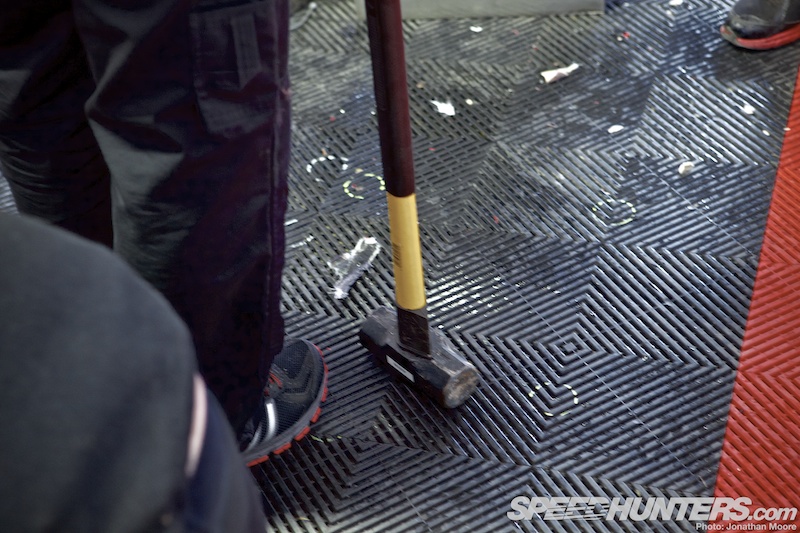
And the hammers were about to get bigger.
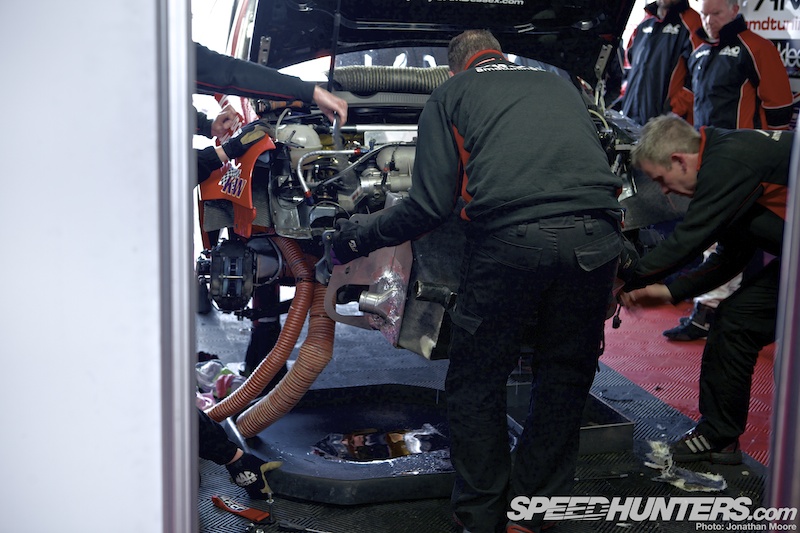
With pans slid into place to catch liquids, the broken radiator was taken out by 2:50pm so work could start on straightening out the main crash structure…
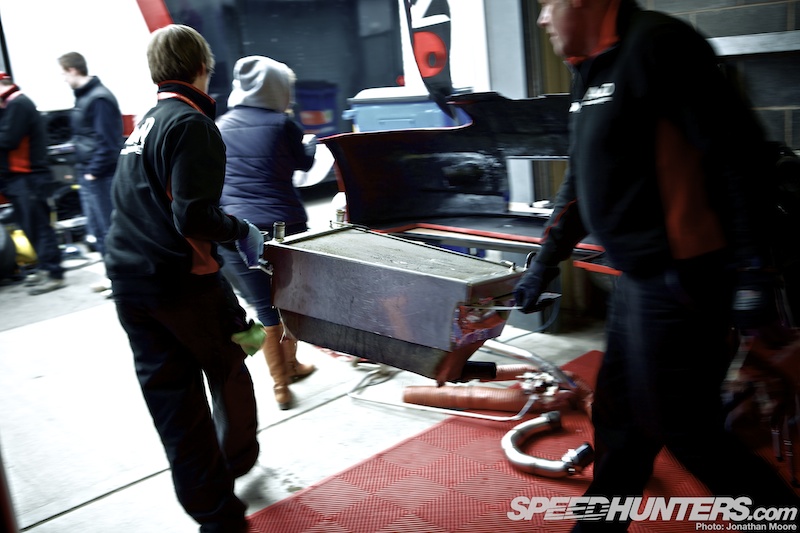
… with the radiator adding to a growing pile of detritus at the back of the garage.
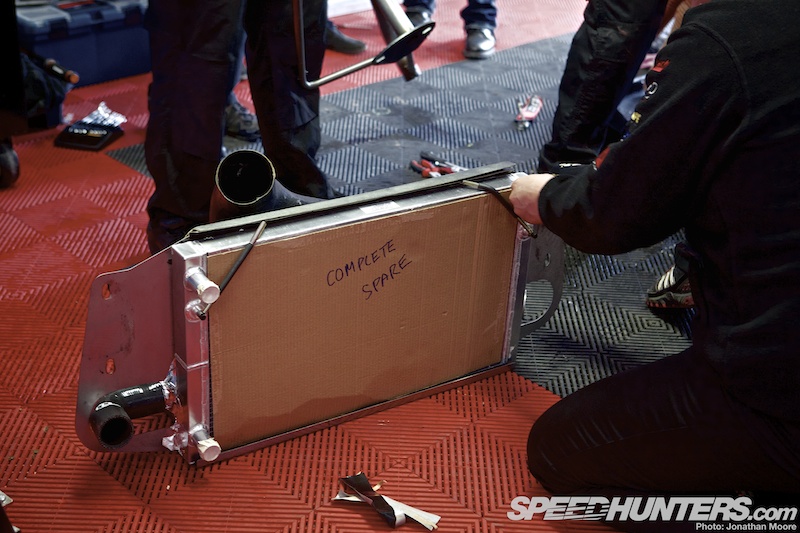
The new radiator was taken out of its box and prepared ready for later installation; this is the fourth year that the AMD Tuning team have been in the BTCC, so they now have plenty of experience of knowing just what spares you need to have to hand. Touring car racing is tough at the best of times.
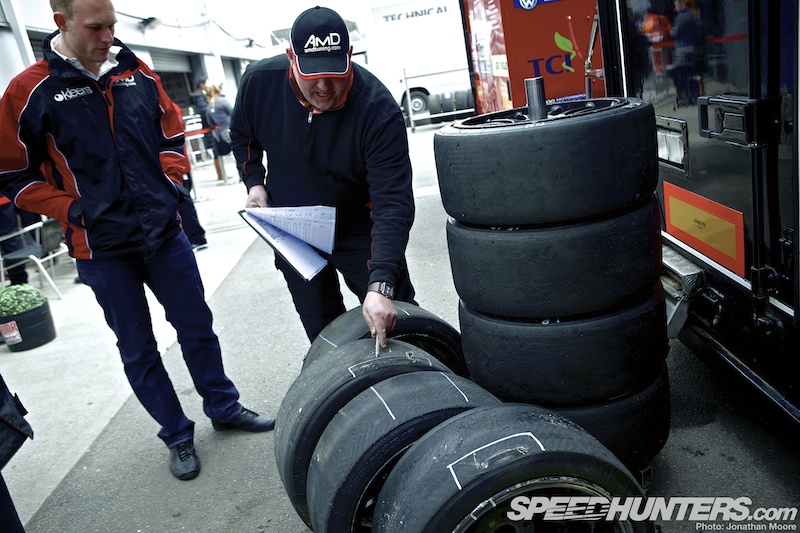
Also out the back of the garage, the tyre technicians examined the tyres to see if they could be salvaged. Rubber is expensive – around a thousand pounds a set – so not thrown away lightly.

I remember seeing a crashed vintage Mustang at the Spa track once, where the team secured the car to a wall and a truck, and then powered the truck up to try and straighten the car out! But for the solid crash structure of the Golf in the confines of the Donington garages, it was sledgehammer time. The strut was severely out of alignment, so the garage echoed to the sound of metal on metal as mechanic Dave Mott wielded the big hammer.
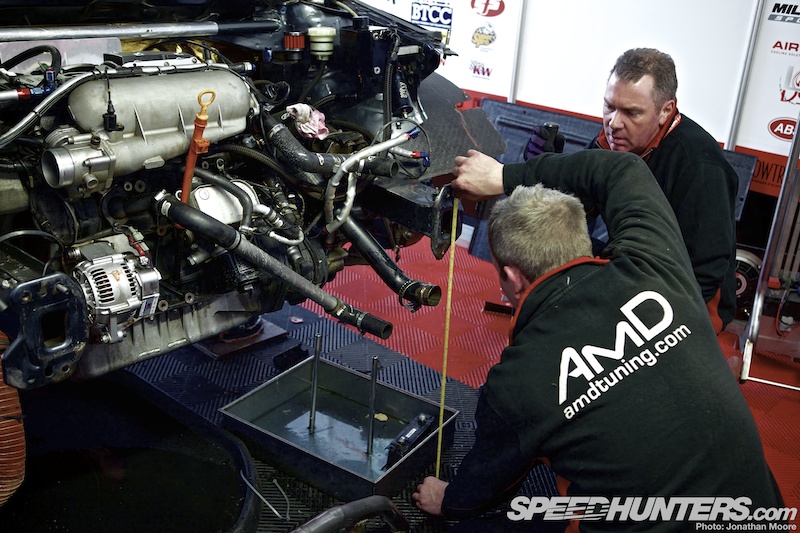
After each major ‘adjustment’, team manager Rob Tickner got out the tape measure to check on progress…
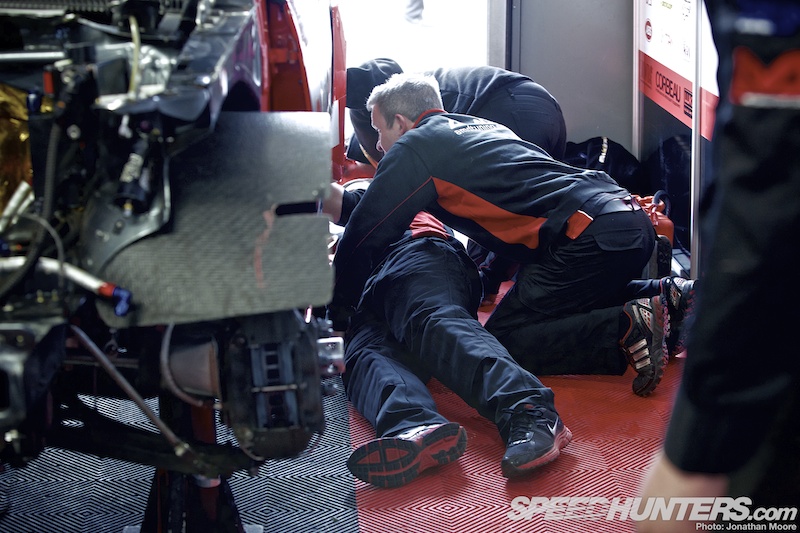
… whilst also overseeing work on the back of the car.
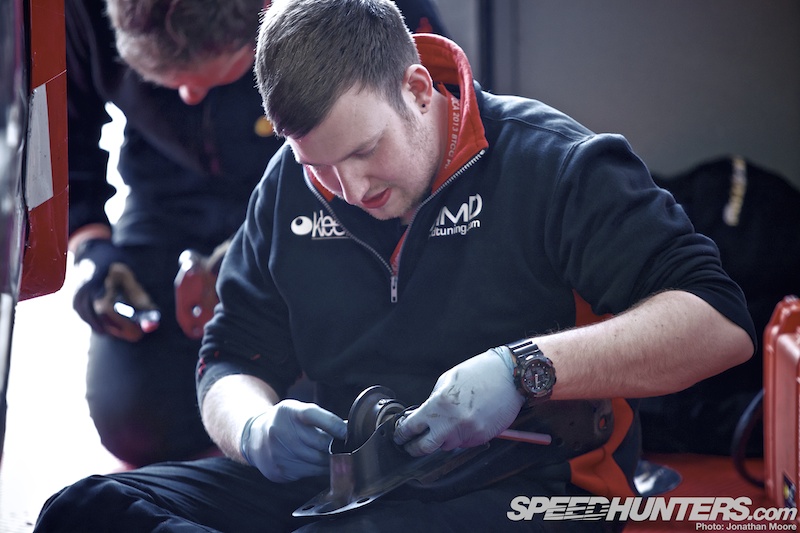
With the door and side patched up, mechanic and gearbox technician Nick Chantler turned his attention to the rear of the car…
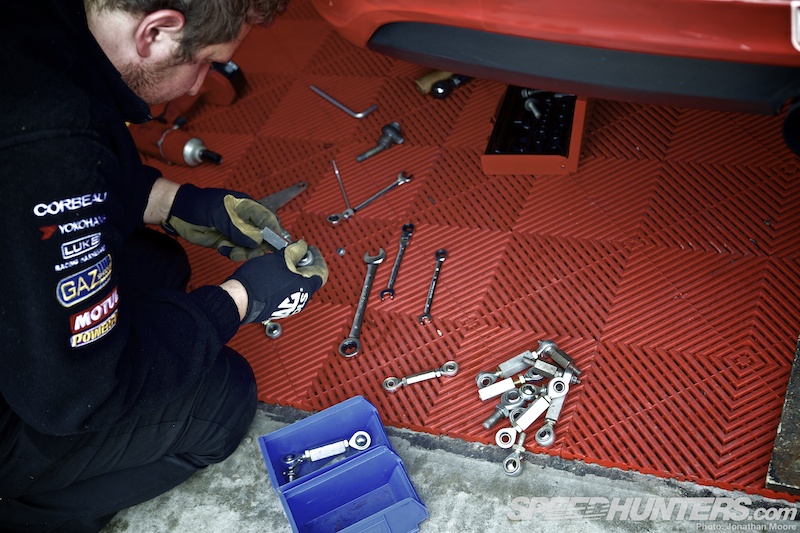
… helped out by logistics manager Nico Ferrari.
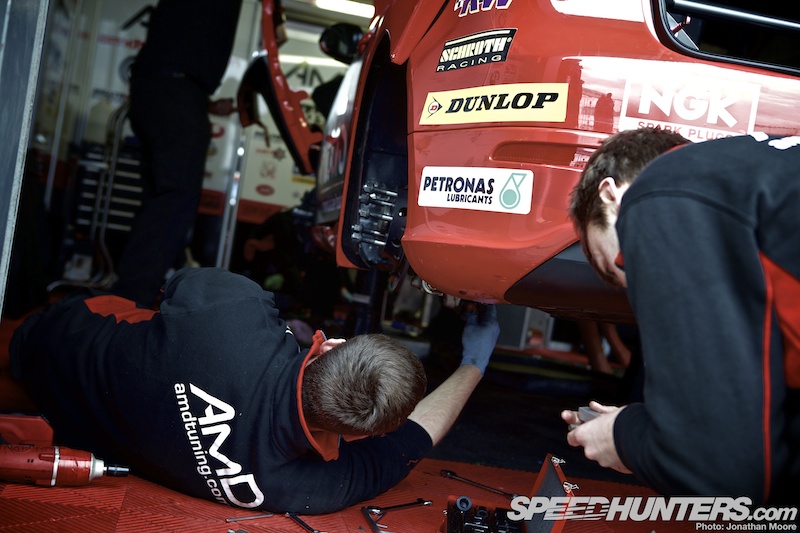
The rear wasn’t in too bad a shape, but a droplink had been broken: both sides would need replacing so they matched.
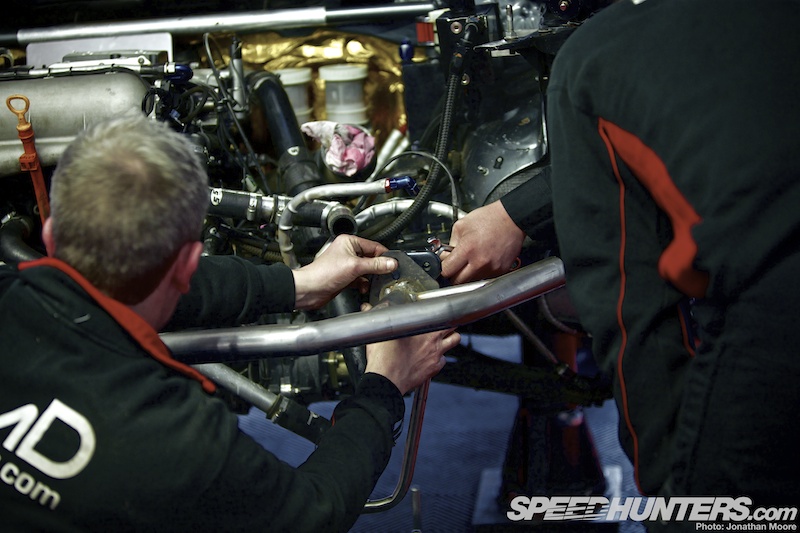
After 20 minutes of hammering up front – and with an hour and 45 minutes left – the struts were back in a close enough position for the front crash bar to be reattached, meaning that the fixings for the other major parts should also line up.

With the tyres dealt with, Andrew Brookes could turn his attention to helping out with the rebuild, taking care of bundling the front hoses alongside mechanic Gary.

For the rest of the team, it was a case of monitoring progress and providing help where necessary. Driver James Kaye and team boss Shaun Hollamby watched over proceedings, whilst I did my best to keep out of the way of the mechanics running to and from the spares and support truck. What amazed me throughout proceedings was the lack of drama – exactly as Shaun had hinted at the previous day as being the strength of his crew. Everyone worked on their allocated tasks, seemingly never falling over each other.
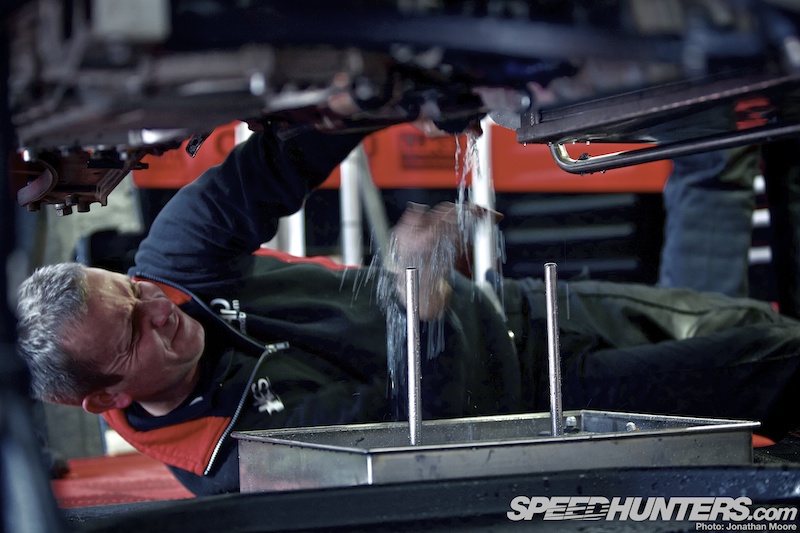
There was just over an hour left. Remaining fluids in the system were drained – rather more dramatically than in normal circumstances – and the new radiator plumbed in.

With the main components back in place, that front bar could be properly installed – which required more persuasion – and the headlight mounting plastic put into place.

The team could now be more confident than ever that they could get the car out. The bonnet was temporarily tried out, to see if the mounting pins lined up…
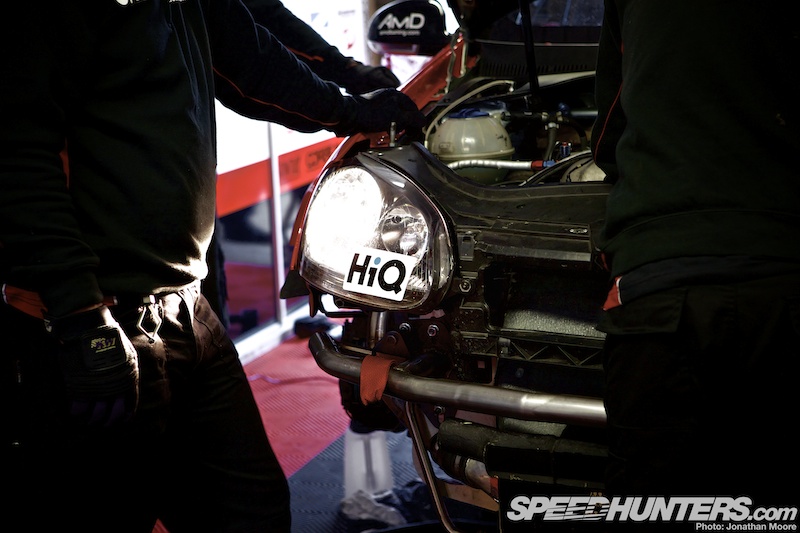
… and then the headlights themselves plumbed in and tested. She lives!
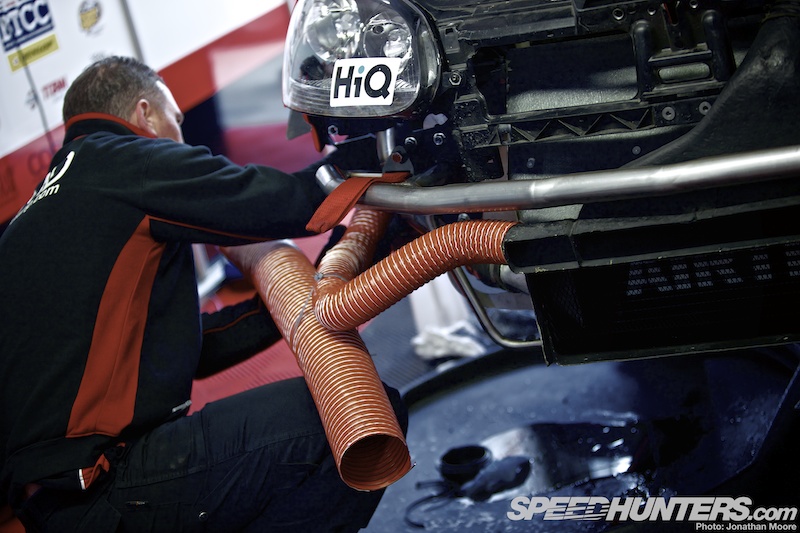
Next up those hose bundles had to be threaded into position…
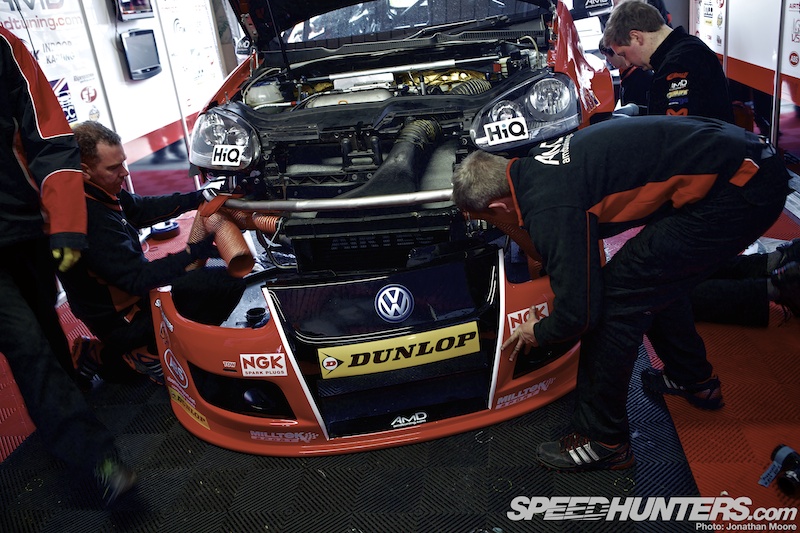
… from the brakes and radiator into the nose mounts. The Golf was once again looking like a racing car.
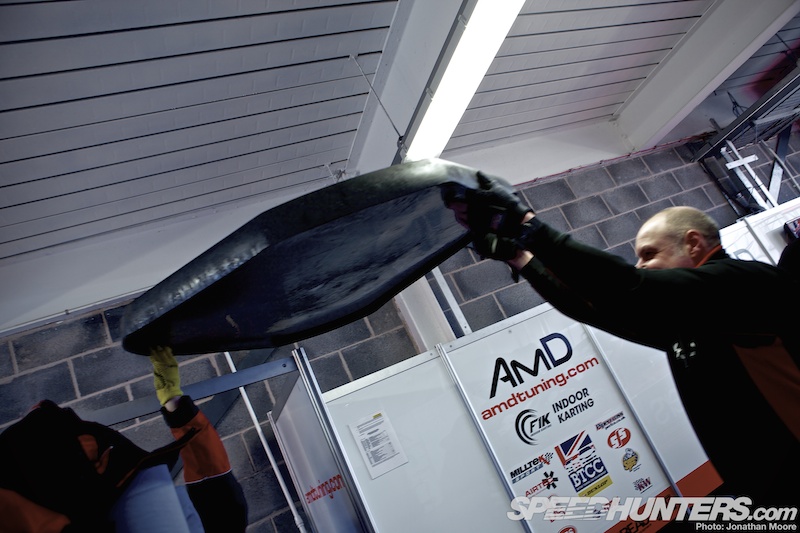
The pans that had been used to contain liquid spills were lifted out over the dividers and emptied out…
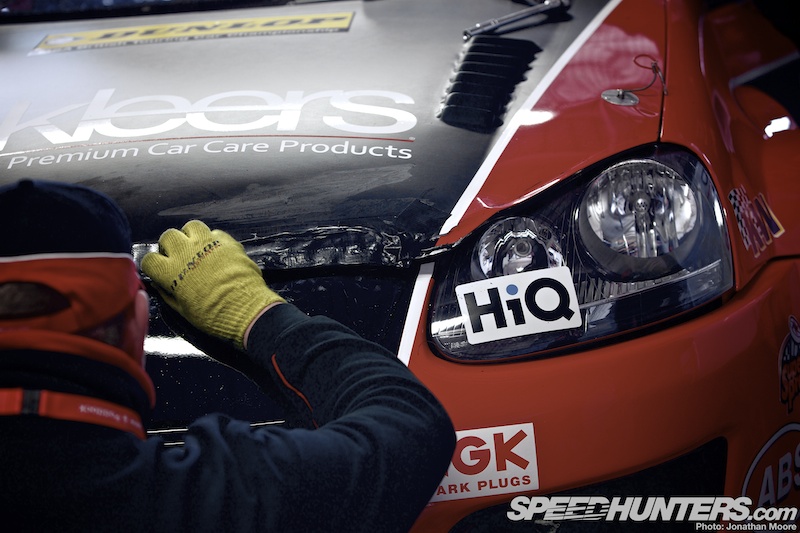
… whilst with 45 minutes to go, an attempt was made to try and make the nose of the Golf look a little less like a bruised prize fighter.
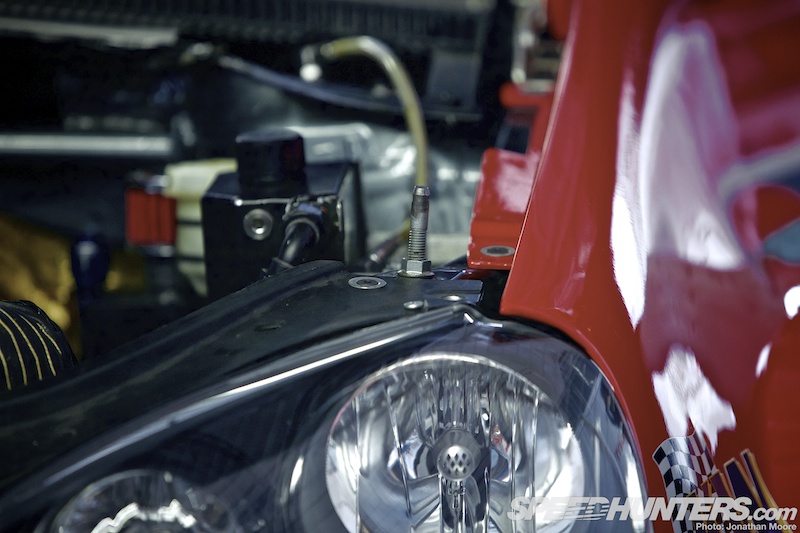
The final challenge was with the bonnet: it wouldn’t quite sit square on the pins, so a combination of hammer and socket wrench were used to get both sides aligned.
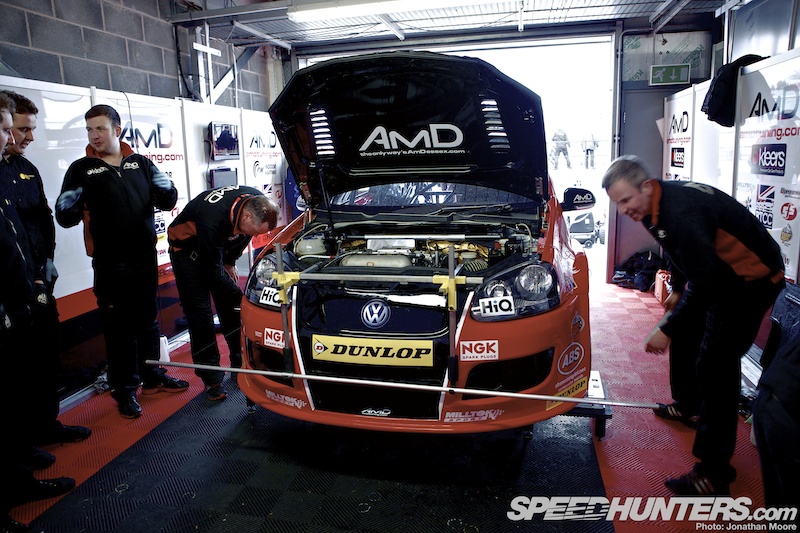
30 minutes to go. There was just time for the car to go back on the pads for a geometry check: this was never going to be as it was when the Golf had rolled into the paddock, but it still meant the team could give James a heads-up on any possible issues.
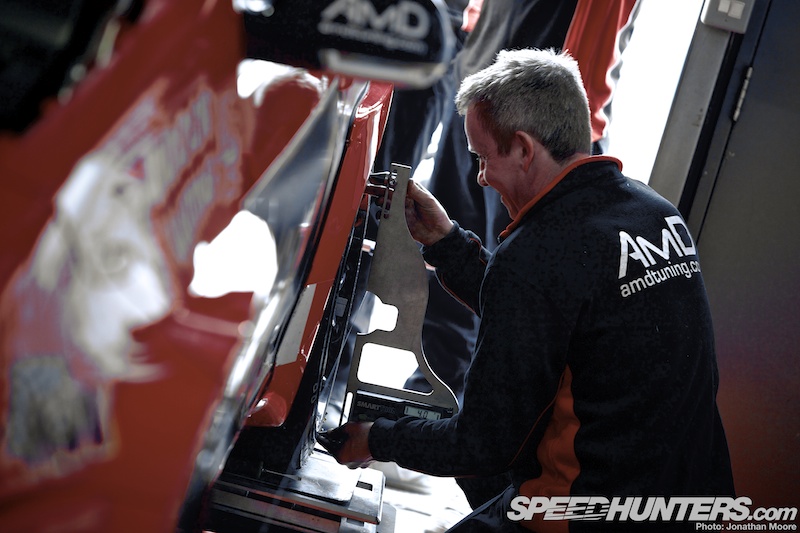
Rob went through his standard programme of checks on camber, toe and track…
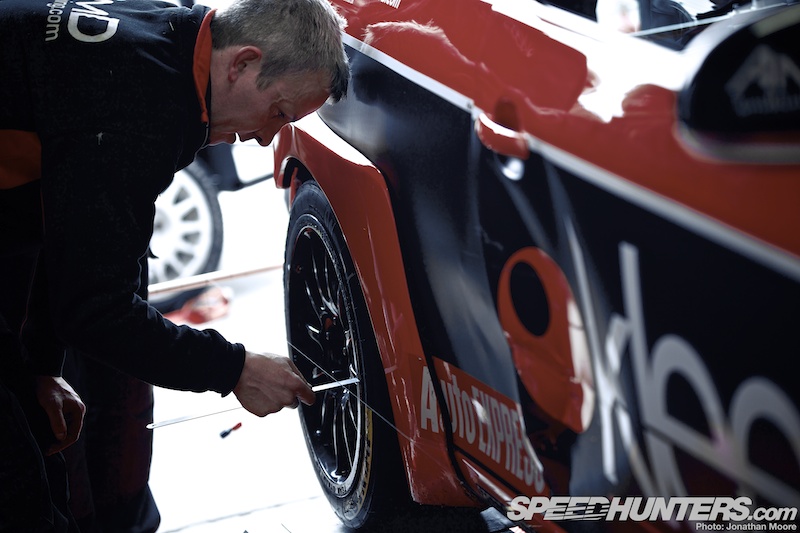
… front and back. The tolerances were all met: the Golf might be a little battle-scarred, but it was back in the fight.
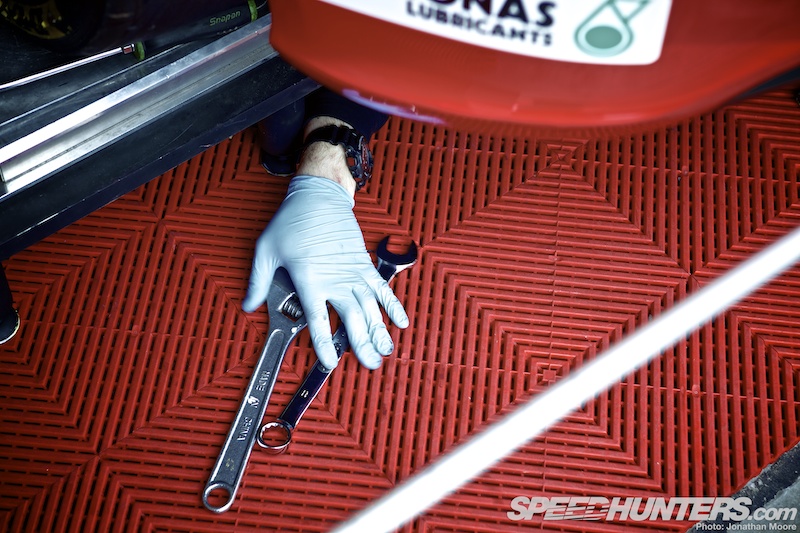
Then the final spanner-checks, which is when you hope that you don’t find a leftover bolt, IKEA-style…
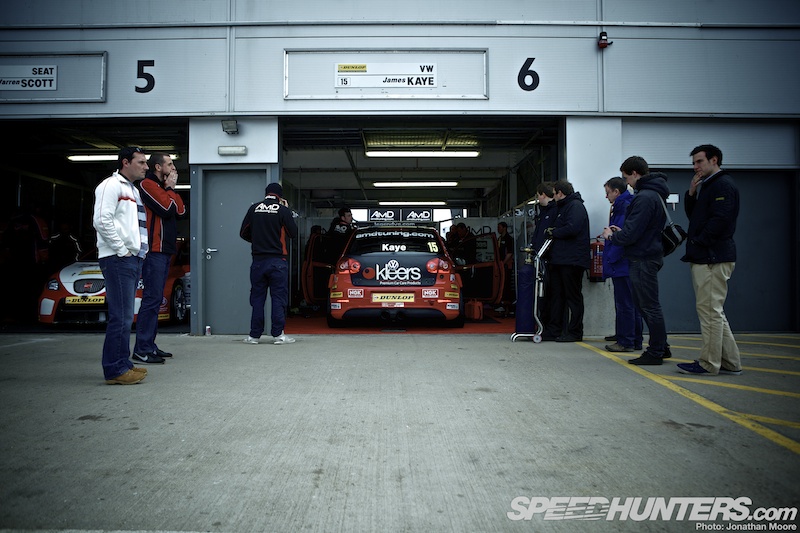
The pit apron outside the garage was cleared as the Golf was lowered down on the jacks and then back onto its own wheels.
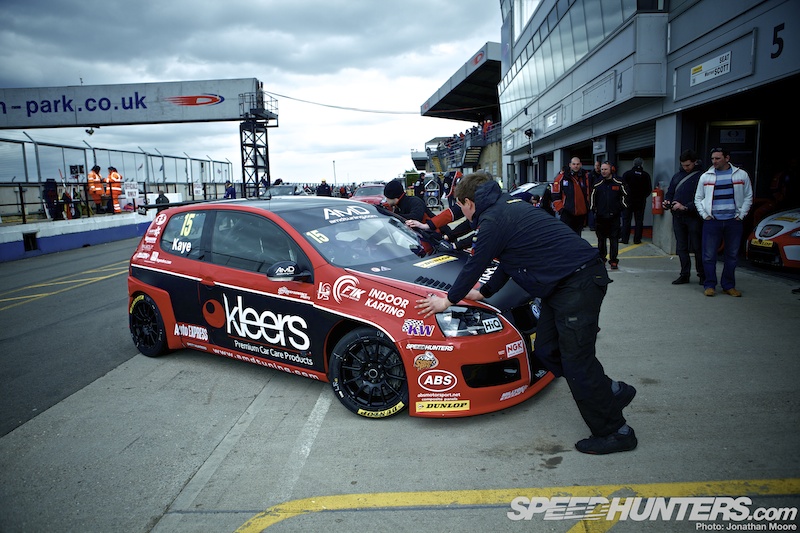
With just three minutes to go the Golf was rolled out onto the pit apron and headed out with the other cars to take to grid: they’d line up right at the back, but they’d be on track. From what appeared like a write-off to a car that – at least from the passenger side – looked ready to take on the BTCC competition. What an achievement.
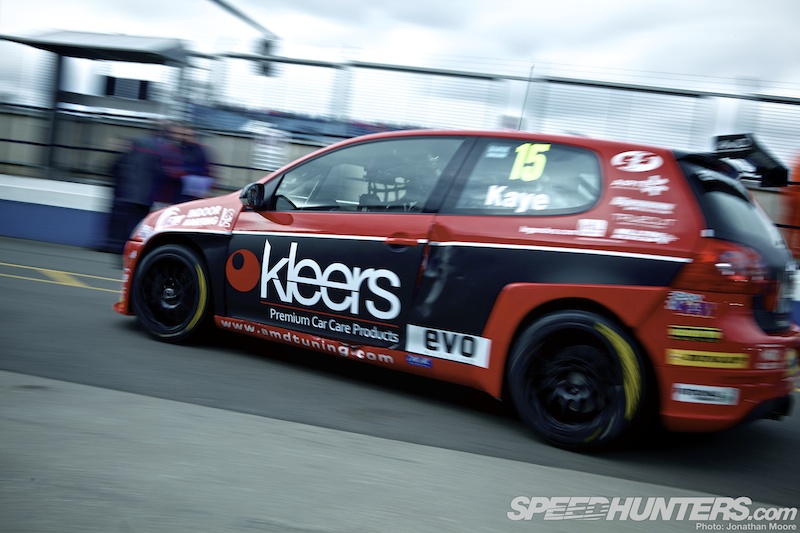
With the two-litre turbo fired up, James eased the car onto the pit lane and went out for his formation lap to take his place on the grid.
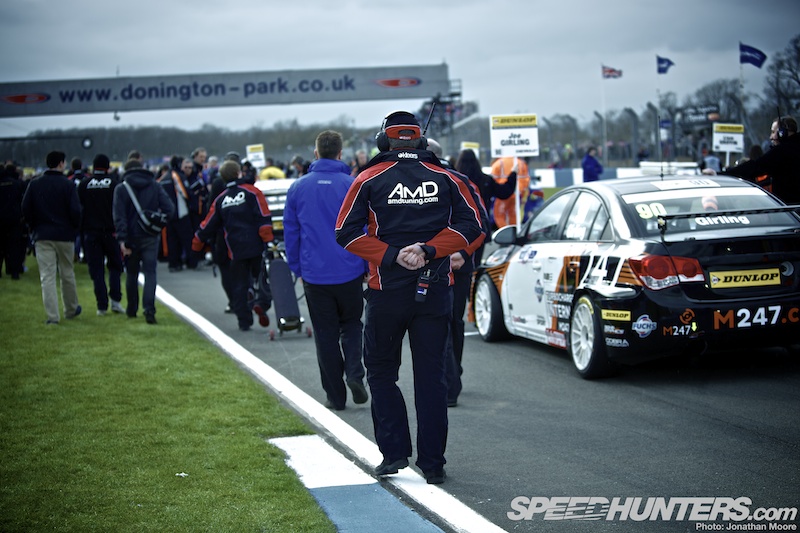
With two hours of extreme effort behind them the team’s work was done, and they made their way back to the pit garage with their equipment.
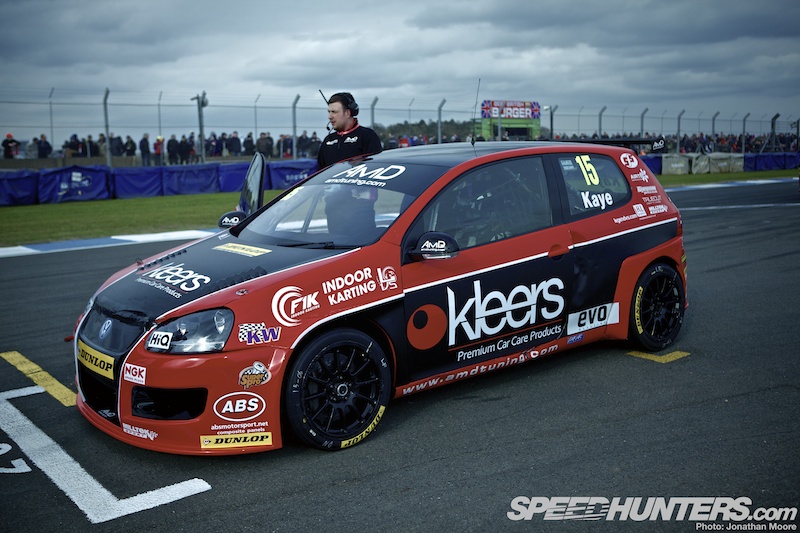
Now it was down to car and driver.
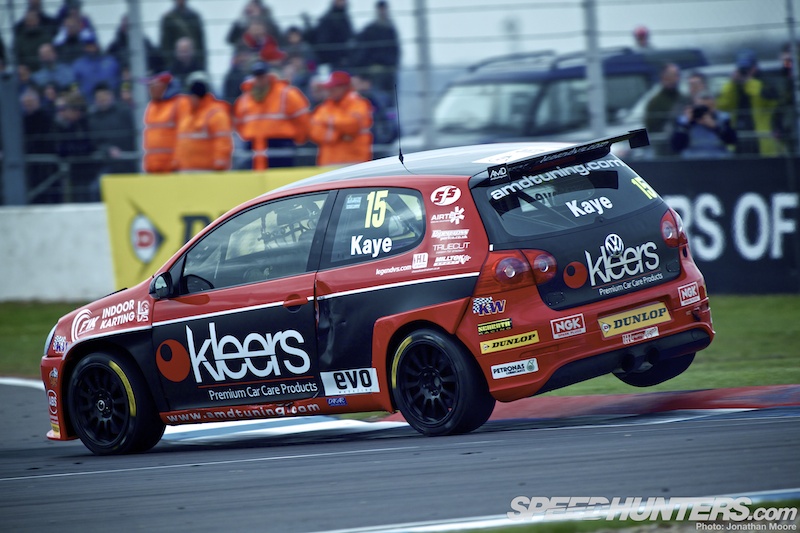
Did James back off at all, bearing in mind the state of the car? Well, I think this picture says it all! Within a couple of laps James was amongst the class front-runners and soon through – and into the lead. But on lap seven the Golf didn’t reappear.
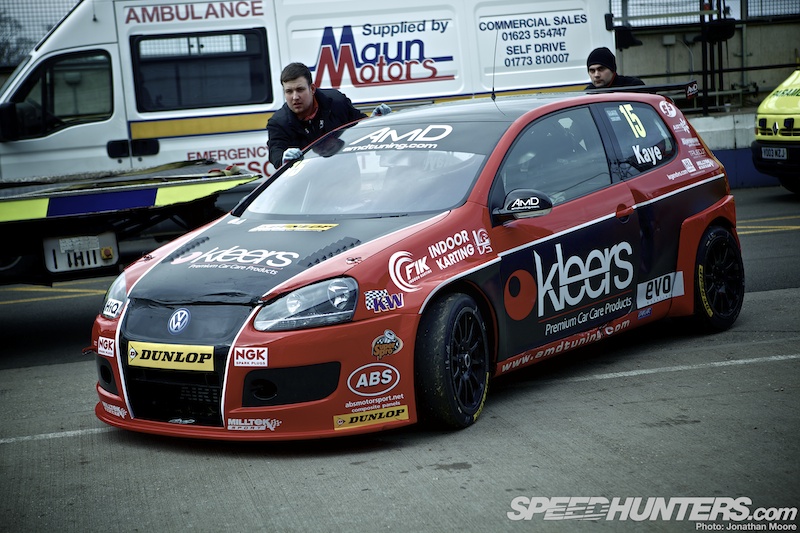
The Golf had stopped out on track, and wouldn’t return until the race had ended.
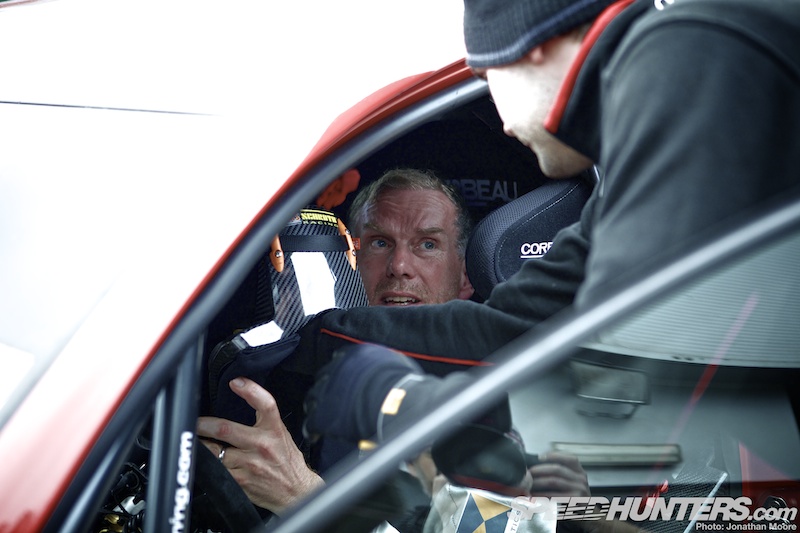
When he was towed back to the garage, James explained that the car had ground to a halt, with first the power steering failing and then other systems breaking: it seems like the accident had also squashed a part of the exhaust and damaged the electrics, so the battery drained and the car cruised to a stop.
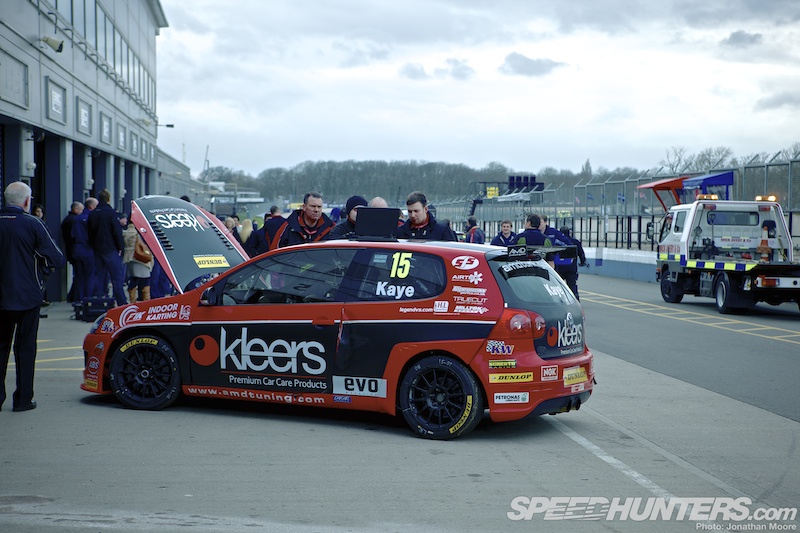
The team had worked incredibly hard. Were they disappointed? Of course. But they were also rightly proud of their efforts, and took heart in the combination of the earlier win and James’ performance in the hobbled Golf in Race 3. I think the biggest thing I always get from following a race team over a weekend is the inspiring teamwork that’s invariably on show – and was more than evident with the way that AMD Tuning dealt with repairing their car. This is a relatively small privateer team, putting on a fine demonstration of what it takes to be a top notch racing team both on the track and off.
Jonathan Moore
Instagram: speedhunters_jonathan
jonathan@dev.speedhunters.com
More BTCC stories on Speedhunters

